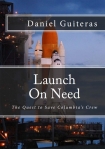Launch on Need, Daniel Guiteras [the giving tree read aloud TXT] 📗

- Author: Daniel Guiteras
Book online «Launch on Need, Daniel Guiteras [the giving tree read aloud TXT] 📗». Author Daniel Guiteras
Chapter 64
Kennedy Space Center, Florida
CNN Mobile Studio
STANGLEY COULDN’T BELIEVE what he’d heard Pollard say. He felt like some rookie, like the countless so-called science reporters he’d met over the years, who knew little and cared even less about the subject about which they were reporting. In his waking and sleeping nightmares over the past two weeks, Stangley had imagined a hundred different scenarios of how Atlantis might fail to make orbit and how the crew of Columbia could die in space. But he was embarrassed to admit that the idea that Atlantis’s tiles could be severely damaged during launch much the way Columbia’s had been, well, that was not something he’d seriously considered. Sure, he knew Atlantis would launch with the same type of ET Columbia used, that there would be no time to implement any changes or improvements to the design of the tank’s foam insulation. He knew all that, but he’d forgotten to consider how falling foam could cripple Atlantis and prevent the rescue crew from saving Columbia’s seven, even if Atlantis made it to orbit. He made a mental note to call Brown as soon as he got off the air to verify the extent of Atlantis’s tile damage.
“Okay,” Stangley said, his earpiece back in, makeup freshened, and technically, but not mentally, ready for more shuttle talk. “Wrapping up a statement there was NASA’s Julie Pollard. It’s certainly a surprise to hear about Atlantis’s tile damage for those of us and you out there who thought getting Atlantis into space on time was the challenge, who thought if we could just do that, then the crew of Columbia could be rescued. Well, as we’ve just learned, the crew of Columbia and now the crew of Atlantis, too, are facing a new danger of not making it back home safely. I can tell you that I am taken aback with this news about the tile damage. Although it sounds like the damage has been thoroughly investigated by NASA engineers, I can’t help but wonder if that is in fact true. I’m not implying that the engineers at NASA are lying to us or that I know more about shuttle physics than they do. What I mean is that I’m worried for both crews. Remember, at first word, engineers didn’t believe that falling foam had ripped a hole in Columbia’s wing. A source inside NASA, someone whose name I can’t reveal, told me that some NASA engineers weren’t convinced falling foam was capable of causing the amount of damage Columbia sustained until they’d seen the actual video recorded during the wing-inspection space walk.
“Because of that doubt, I have to question how much is really known about the resiliency of the tiles, whether we can be certain the damaged tiles won’t be a factor for reentry.” Stangley heaved a sigh, paused. “I guess we’ll have to say our prayers that the tiles hold during reentry. The worst of it is that not just the Columbia crew but also the Atlantis crew, all eleven astronauts, have no other choice. They must use Atlantis, whatever shape she’s in, to come home.” Stangley grabbed his orbiter models deliberately, hoping the tears that blurred the edges of his vision would dissipate if he changed the subject and moved ahead with a demonstration.
“I want to review for you some of the first things astronauts on Atlantis will be doing now that they’ve reached their final rendezvous position in orbit. There are a number of things they will need to do even before starting the EVA and the transfer of Columbia’s crew. First thing will be…”
GARRETT AND MULLEN secured their feet into foot straps fastened to the floor at the flight deck’s aft workstation. The workstation was complete with a rotational hand controller, a laptop computer and several display panels. The back wall of the flight deck, the aft bulkhead, served as a wall between the living quarters of Atlantis and the payload bay. Mounted high in the aft bulkhead were two windows that allowed astronauts to view payload bay activity from inside the orbiter, and move cargo in and out of the payload bay using the remote manipulator arm mounted along the port side of the payload bay. For now, though, the windows were dark, since the closed payload bay doors blocked out any available sunlight.
“Houston, Atlantis. We’re ready at panel R-13,” Mullen called out. “Ready to initiate auto PBD sequence.”
Garrett looked over at Mullen and whispered, “Are you gonna tell ’em every time you have to take a pee, too?”
“Hey, I’m callin’ out everything,” Mullen replied. “I’m going to have a perfect mission. No one’s getting stuck up here ’cause of me.”
“Atlantis, Houston, you’re go for PBD opening.”
“Roger that,” Mullen replied, smiling back at Garrett and hitting the switch to start the autosequence. “See, it’s not so hard getting permission first.”
The port and starboard payload bay doors were comprised of five joined sections that ran 60 feet. When closed, the two doors formed the upper back of the orbiter. Shortly after an orbiter arrived on orbit, the payload bay doors were to be opened to allow radiators mounted on the inside of the doors to get to work regulating the orbiter’s temperature.
Mullen reached out and flipped the auto PBD switch on panel R-13.
The two astronauts waited patiently for the mechanical symphony





Comments (0)